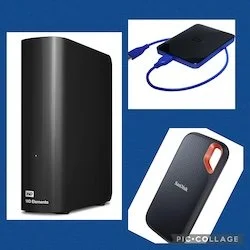External Hard Drives 101
Why You Should Consider Using an External Hard Drive
If you're like many people, your phone or computer is overflowing with photos—and you're constantly running out of space. As someone who helps others organize their photo collections, I hear this frustration all the time.
Tired of storage warnings?
External hard drives (EHDs) are a smart, practical solution for anyone with a growing photo library. As technology evolves, many newer devices come with limited built-in storage, which can be a real challenge if you love capturing memories. That’s where an external hard drive comes in handy—it gives you the extra space you need.
Unfortunately, many people are hesitant to use them because they seem complicated. But don’t worry—this guide will break things down in simple terms so you can feel confident using one.
More Than Just a Backup
When you think “external hard drive,” you might immediately think “backup.” And yes—they’re excellent for that! But they can do more. Think of your EHD as an extension of your computer’s storage. It gives you room to breathe and work on photo projects without hitting those annoying “disk full” errors.
Because they’re portable, you can also take your EHD with you and access your files on other devices or keep your photos safe when switching computers.
Cloud Storage Isn’t Always Enough
Cloud storage is convenient—until you can’t access it. Maybe your WiFi is down, or you get locked out of your account. That’s why keeping a physical copy of your photo library on an external drive is so important. It puts your memories right at your fingertips—no internet required.
We'll explore more about backup strategies in the next newsletter (May 1, 2025).
Understanding Your Options: SSD vs. HDD
There are two main types of external drives:
Solid State Drives (SSD): Fast, durable, and compact. They cost more but are great for frequent use.
Hard Disk Drives (HDD): A budget-friendly option that uses older technology and is a bit slower.
Personally, I’ve had great experiences with brands like Samsung, Western Digital, and Seagate - heard Toshiba is also good. For most people, a 2TB SSD hits the sweet spot—it holds tens of thousands of photos and is a reliable size.
One Drive Works for Both Mac & PC
Although drives are often labeled for either Mac or PC, the hardware is identical. What matters is how you format the drive. Formatting prepares the drive to work smoothly with your device and improves performance.
Important: Formatting a drive erases everything on it—only do this with new or blank drives.
Common Formats:
APFS / Mac OS Extended: Best for Mac, especially if you're using it with the Apple Photos or iCloud Photo Library.
NTFS: Ideal for Windows users.
ExFAT: Compatible with both Mac and PC, but may run slower.
FAT32: Works across platforms but not recommended for large photo libraries due to file size limits.
If you need to share drives between systems, there are also tools like NTFS for Mac or MacDrive for PC to help bridge compatibility gaps.
How to Format Your External Hard Drive
For Mac:
Open “Disk Utility” (found in Applications > Utilities).
Select your drive and click “Erase.”
Choose a name and select APFS or Mac OS Extended.
Set the scheme to “GUID Partition Map” and click “Erase.”
For PC:
Open File Explorer and right-click the drive.
Choose “Format.”
Give it a name, select NTFS, and click “Start.”
If “Format” isn’t listed, search for “Create and format hard disk partitions” in the Start menu.
Taking Care of Your External Hard Drive
With proper care, external hard drives can last years. Traditional HDDs average 4–5 years, while SSDs may last even longer.
To extend their lifespan:
Keep them in a cool, dry place.
Handle them gently (never drop them).
Always eject them safely before unplugging.
Ejecting Matters!
On Mac: Drag the drive to the Trash icon.
On PC: Click “Safely Remove Hardware” in the system tray and choose your drive.
If the system says it can’t eject, I recommend shutting down the computer first, then unplugging.

